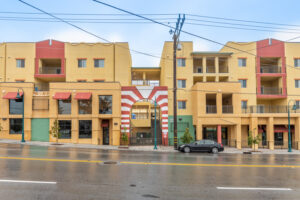While we typically have a fire sprinkler consultant on the design team for our projects, there are some key things that Architects must know about the systems that can influence design. The NFPA (National Fire Protection Association) has a variety of requirements for different types of projects. This post specifically discusses projects with sleeping areas such as residential, healthcare, hospitality or dormitory types of buildings.
NFPA 13 is a “fully sprinkled” system where NFPA13R is a “partially sprinkled” – a watered down version of the full NFPA13, pardon the pun. Note that the fire protection industry regularly uses the term “sprinklered” which has always struck me as grammatically incorrect, so I prefer to use the term “sprinkled”. You will see both terms throughout the building industry.
The first question is: Where can NFPA13R be used?
While there are always exceptions to the rule, and you should always consult your Architect, fire protection consultant or building official, NFPA13R can typically be used in most hotels and motels, apartment buildings, townhomes and condominiums 4 stories or less, and larger single family homes (most single family homes would actually qualify for an even more reduced requirement in NFPA13D). Meanwhile, the full NFPA13 would be used in hospital resident rooms, nursing homes, dormitory style housing, and multi-story residential over 4 stories.
Why is this important? Because NFPA13 requirements can add significant cost for additional protection that is not required by NFPA13R. In a 13R building, attics, closets and bathrooms typically do not have to be sprinkled. 13R also allows for a lower level of water discharge than 13, which results in smaller pipe sizes. 13R also requires a shorter water supply duration than 13, which can reduce the need for storage or pumps.
In most cases, you can avoid sprinkling floor and roof cavity space in a 13 system if the cavities are filled (typically with insulation). This can result in significant cost savings, but there are a lot of details involved and things to look out for. Especially if you are mixing uses, like multifamily over commercial retail or office, or podium buildings with structured parking.
If you have any concerns, please contact us and we would be happy to help you with your project!











6 thoughts on “What’s the Difference Between NFPA 13R and NFPA 13?”
Prakash, I’m not sure that I understand your question, however all technical questions regarding your actual system installation should be approved by your local jurisdiction having authority. This is especially important if you are not using a trained professional contractor to install the system. Best of luck with your project!
is it required by pas valave in sure test drain for zone control valve in 3 floor residential villa with domestic water pump and water tank ?
Celine,
At first blush, your project sounds like it should be a 13R classification. However, local jurisdictions and their fire departments have complete authority to set additional requirements, so only a proper code analysis for your specific project in the context of your local jurisdiction could confirm that. We can provide that service for you if you need, so just let us know if you need any assistance with that. Thanks!
I am still a bit confuse on when to use NFPA 13 and 13R. We are planning to build a residential building : dormitory style, because rooms won’t be individually equipped with cooking facilities. The building will have 3 story and 100 rooms total. Which NFPA should be considered in this case : 13 or 13R?
Generally, yes. Though you would need to confirm the specific system specs with the installer to make sure it is compliant with 13, 13R or 13D.
Could all systems 13, 13R and 13 D have dry sprinklers as part of the system in ourdoor covered areas?
Comments are closed.